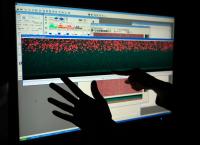-
STAMI-SMI Professor Curtis's Lab Grows Natural Polymer Brushes from Surfaces Enzymatically
New work reported from the labs of SMI Professor Jennifer Curtis (School of Physics) introduces a versatile platform to grow ultra-thick, dense hyaluronan (HA) polymer brushes from surfaces using immobilized fragments of enzyme-rich bacterial membranes. This new method provides a path to improved biocompatibility and dynamic control of biointerfaces that potentially can be grown in vivo or regenerated after wear. The research was published in Nature Communications under open access (Nat. Commun. 2019, 10, 5527).
-
When Sand-Slithering Snakes Behave Like Light Waves
Desert snakes slithering across the sand at night can encounter obstacles such as plants or twigs that alter the direction of their travel -- and cause them to mimic aspects of light or subatomic particles when they encounter a diffraction grating. The study was coauthored by SMI Professors Dan Goldman and Zeb Rocklin: Perrin E. Schiebel, Jennifer M. Rieser, Alex M. Hubbard, Lillian Chen, D. Zeb Rocklin, and Daniel I. Goldman. Proc. Natl. Acad. Sci., USA, February 25th, 2019.
The full article on Research Horizons.
-
2018 STAMI Industry Partners Day
Georgia Tech's Center for the Science and Technology of Advanced Materials and Interfaces (STAMI) held its 2018 STAMI Industrial Partners Day and Exposition on Sept. 27-28, 2018 at The Historic Academy of Medicine. The meeting featured talks from leaders in industry and academia, student presentations, and networking opportunities.
-
SMI Researcher Bhamla to study One of the World’s Fastest Creatures
Soft Matter Incubator (SMI) member Saad Bhamla (School of Chemical and Biomolecular Engineering) has received a four-year National Science Foundation (NSF) grant to study Spirostomum ambiguum, a tiny single-celled protozoan that achieves blazing-fast acceleration while contracting its worm-like body. The physics and mathematics of the movement could help advance nanotechnology and accelerate a new generation of robots barely large enough to see with the naked eye. Read more in Research Horizons.
-
Material Formed from Crab Shells and Trees Could Replace Flexible Plastic Packaging
New materials developed in the labs of GTPN, CRĀSI, and SMI member Carson Meredith derived from crab shells and tree fibers has the potential to replace the flexible plastic packaging used to keep food fresh. GTPN, CRĀSI, and SMI members John Reynolds and Meisha Shofner were also part of the team.
The new material is described in the journal ACS Sustainable Chemistry and Engineering. See the Article in Research Horizons.
-
Perking Up and Crimping the ‘Bristles’ of Polyelectrolyte Brushes
The labs of STAMI member Blair Brettmann (GTPN, SMI, School of Materials Science and Engineering) have created a molecular-sized brush that looks like a shoe brush and has properties with great potential for the materials industry and medicine, but polyelectrolyte brushes can be sensitive, and getting them to work correctly is tricky. New research shows what can make them break down, but also what can get them to systematically recover.
See the Article on Georgia Tech Research Horizons.
-
Inaugural Industrial Partners Day
STAMI held its inaugural Industrial Partners Day and Exposition on October 19th-20th at Geogria Tech's Historic Academy of Medicine in Midtown Atlanta. The event was attended by over 20 different companies interested in advanced materials and interfaces and by over 150 Georgia Tech faculty, students, and researchers from a variety of schools within the College of Engineering and the College of Science. Professor George M. Whitesides from Harvard University delivered the Keynote Address while both Georgia Tech faculty and Industrial speakers participated in presentations and networking opportunties.








